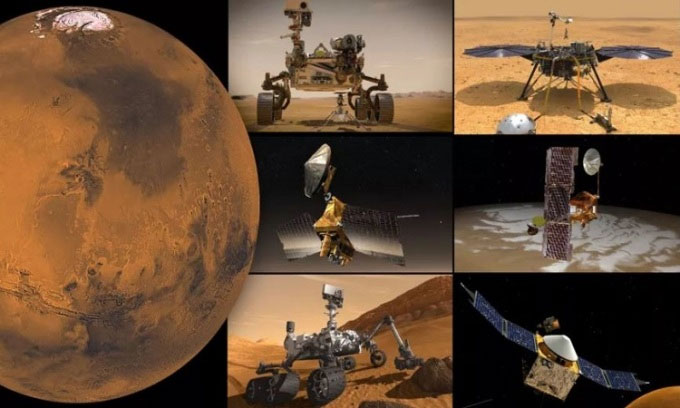NASA lost contact with Mars robots for two weeks
NASA will shut down most Mars rovers from October 2 to October 16 for safety reasons related to the red planet's position in space.
On October 7, Mars will enter a position in its orbit called a "solar conjunction," which occurs every two years as the planet moves behind the Sun, as seen from Earth. The corona, the outermost layer of atmosphere surrounding the Sun, is in line of sight, which could disrupt communication between the planets, according to NASA.
NASA says the position of Mars can affect the sending of commands, leading to unintended actions from deep space robots , including three orbiters, two rovers, and a station. lander and a helicopter operating on Mars. The Sun conjunction also affects other missions on the red planet of Europe, China and India.

NASA's Mars rovers and spacecraft. (Photo: NASA)
Most of NASA's missions will stop receiving commands and stopping sending unprocessed images between October 2 and 16, although the time period can vary by 1-2 days in some cases. During that time, NASA will give the robots jobs that can safely perform themselves when contact is lost.
NASA's Perseverance robot, which landed on Mars in February 2021, will conduct weather measurements, search for sandstorms that sweep across, experiment with radar and listen to sounds in the environment with a microphone. Perseverance will also look for good gear stops to wait through lost contact times.
The Ingenuity helicopter has experienced several long and difficult flights in recent weeks, although the vehicle has since been halted while NASA calculates how to safely fly in the conditions of the seasonally thin Martian atmosphere. NASA has not announced the next flight schedule. Maybe Ingenuity will wait through the first two weeks of October. The helicopter will be parked 175 kilometers from Perseverance and send weekly status updates to the rover.
The Curiosity robot, which has been working on Mars since 2012, will measure weather and radiation, and look out for dust vortexes. Curiosity has been active for several solar conjunctions and has not had any major problems.
The in-situ InSight lander will continue to use seismometers to detect large earthquakes on Mars.
Three veteran NASA orbiters, the Odyssey, Mars Reconnaissance Orbiter (MRO) and Mars Atmosphere and Volatile Evolution Mission (MAVEN) will send status updates from missions at the Martian surface back to Earth. The trio of spacecraft also made their own scientific observations and returned to Earth when conditions were more favorable.
Once the solar conjunction has passed, the engineers plan to upload about a week's worth of information via NASA's Deep Space Network, a system of radio antennas around the Earth that specializes in picking up signals from the mission. deep space. The spacecraft's operations will return to normal after NASA completes the data collection process.
- NASA lost contact with the Mars probe
- NASA lost contact with the Mars explorer car $ 400 million
- The Global Mars Surveyor is missing due to human error
- Mars probe MGS does not respond to the signal
- Mars research paused in April because of the sun
- Mars amphibious robots lost contact with Earth
- NASA lost contact with the international space station
- Top 10 photos of Mars
- NASA is about to announce the discovery of a tremor about Mars
- If a 'million dollar' satellite suddenly disappears, what will NASA do?
- Robot explorer Mars moves worm-type
- NASA is about to launch new Mars explorer robots: Find alien life
 Announced 3 houses on the Moon and Mars
Announced 3 houses on the Moon and Mars Science proves: Mars also knows 'deflated'
Science proves: Mars also knows 'deflated' Elon Musk announced the price for a Mars trip was 11.6 billion VND, free of charge
Elon Musk announced the price for a Mars trip was 11.6 billion VND, free of charge NASA discovered strange 'gate' on Mars, is the hiding place found?
NASA discovered strange 'gate' on Mars, is the hiding place found?